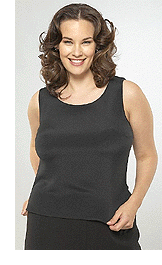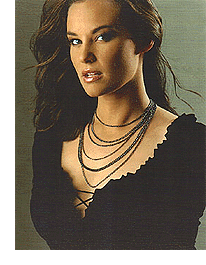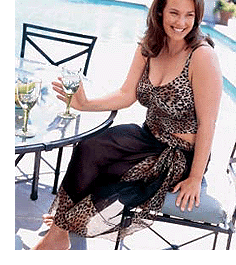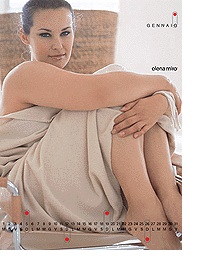
An Interview with Barbara Brickner



|
Barbara Brickner is much more than just one of the top working plus-size models in the world. She has an avid public following, and her images have done much to challenge (and change) society’s attitudes towards full-figured femininity. Thus far, however, she has sought little publicity, and has preferred to let her images speak for themselves, so it was a great honour to be granted the first Web interview with this celebrated model. Mrs. Brickner is cognizant of the broader cultural ramifications of the industry which she represents, and acknowledges its role in bringing about an appreciation for a more timeless standard of beauty. It was a privilege to be allowed to inquire about her feelings on those matters, about her career, and about the industry in general. BB: Hi Heinrich. HSG: I can’t tell you what an honour it is to finally speak with you. BB: Thank you. It’s a pleasure to finally talk with you. I’m sorry it’s taken so long. 
HSG: I understand completely. When I was told that you would be tied up for a few days, I immediately thought, “Good,” because I knew it meant that you would be off somewhere creating beautiful images. In fact, the only thing that would worry me is if you were not busy. BB: Definitely. HSG: First of all, let me say that it has been a joy to have been your unofficial Webmaster for several years now. BB: I think your work is beautiful, by the way. HSG: Wow, thank you for saying so. I always felt that your images were worth preserving in a more lasting form than in a magazine or a flyer, which might be thrown away after one read-through, so with your Encomium site I wanted to create a permanent “frame” to keep your images before the public. BB: Thank you very much. I appreciate that. HSG: I’m delighted to be given this chance to let the public learn a little bit more about you. Incidentally, do you realize that everyone who knows you—Tracie Stern, everyone—has nothing but the most wonderful things to say about you? BB: Well, that is very sweet. I needed that today, Heinrich. I’m having a—you know…[Laugher] HSG: A bad day? BB: No, you know what? I have a baby. That’s part of it. I am a mother, first and foremost, and then I am a model, so it’s quite an interesting balance. But it’s so nice to hear that, and I feel the same way about Tracie. 
HSG: Since you mention your daughter, allow me to say how much I loved the image of you with your daughter Rebecca in the latest edition of Ciao, Magre magazine. Do you have a copy? BB: I have it, but I have the Italian version. HSG: Well, it reads better in English—unless your Italian is better than mine! BB: No, I can pick out the really simple words. They are a wonderful client. They’re one of my main clients, as you know. And quite often, I do bring my child with me, so at one point they asked if we could do a photo together. I missed one issue during my pregnancy, so they wanted to tell their clientele about me, and what was going on in my life, so they asked if we could show a picture, and I actually really like the picture that they chose. HSG: I couldn’t agree more. As you know, one of my favourite practices is to compare modern photographs with images from the history of Western art, and it struck me right away how much that photograph of the two of you resembled a Madonna-and-child painting, as Raphael might have conceived it. Do you think that they did that deliberately? BB: Well, this client—I’ll tell you Heinrich, they are so forward-thinking. And what’s interesting about that is, it’s forward-thinking in this day and age, but, as you know, and as you talk about in your Web site, for centuries women were celebrated to have curves, to have a body, to have a beautiful, curvaceous figure, and suddenly, in the last thirty years, it’s just completely changed. I think this client understands that, yes, we need to show the woman as curvaceous, etc., but they do it in such a beautiful manner that it’s respectful of the plus-size figure, and of the body. I don’t know that they purposefully do it, I think the photographer just sees the person for who they are, and tries to portray that, and it’s always such a pleasure to work with them. 
HSG: I’m sure. They always come up with such brilliant concepts. Undoubtedly, the most notable of these was the famous Barbara Brickner Calendar of 2001. I have always wanted to know—how did it feel to be the first plus-size model to have a calendar all your own? “Supermodels” like Cindy Crawford put out calendars of themselves all the time, and for years, the public has been asking when we would see a calendar featuring plus-size models. And when it finally happened, you were the one whom Elena Mirò chose to be their calendar model, to “represent twenty-first century womanhood,” as they put it. And was it ever shot well! BB: Oh my goodness, yes. I was very excited. You know, I wish I knew what the planning was behind that. I’m not positive that that was even the thinking behind that shoot. I think that it just was such a powerful shooting experience—which really comes along very rarely, and there are good shoots where everything technically goes okay—but for some reason, at that particular time, we just all seemed to “gel,” and every picture that we tried to do just turned out so great. I mean, the lighting was amazing, the locations…It just happened that they had enough photos to try and come up with a concept. So, as far as I know, that’s what happened. As far as how I felt, of course, I was extremely thrilled, especially in light of what they were trying to do with the pictures. They were just stunning. And I’m saying that— HSG: No, I’m thrilled that you speak of the work that way. I think that there is a tendency among some plus-size models towards “false modesty,” and I’m so glad that you can appreciate the impact— BB: Well, I appreciate a beautiful image. I think that’s the most important thing, because it’s one thing to sell a shirt, or to sell a pair of pants, but it’s a whole other matter to actually sell an idea. HSG: That’s such an important consideration. While the nominal purpose of what you do, as a plus-size model, may be to sell a garment, there is another purpose that is far more important, far more powerful, and that is, to make the viewer realize that this image is an expression of true beauty—a kind of beauty that should be celebrated, even though the mainstream media resists it. 
BB: I think that’s a really important point, Heinrich, but unfortunately, there’s part of it that I do have to disagree with you a little bit on. There are clients like Elena Mirò, there is a high end. But, there are certain clients—which I probably can’t name— HSG: Of course! BB: —I don’t want to sound demeaning by any means, but [to them,] the clothing is the most important issue, and the most important facet of what they’re doing, so if there’s a wrinkle in the front they need to take the clothing off and iron it out. It becomes very stiff and unnatural and not really about the model or the image, which—let’s be honest, that’s what we’re trying to do, is sell clothes. HSG: That reminds of a running debate that I have with Tracie Stern. She gives me the honest truth—the grim truth—about the industry, and points out (much to my chagrin) that some clients will simply be looking for, say, a generic blonde in a certain size range, just as a coat-hanger. And my response is, that can’t possibly be true—even though I know it is—because the difference in effect between the images of a beautiful model, and one who is not so attractive, is tremendous. BB: Yeah, I think it’s…I think both of you are right. I think Tracie’s comment is very true in fifty percent of the cases. For instance, last week I was on hold for a client who wanted to shoot in Miami, and they needed a couple of days with the models, and they put me on hold for it, and they came back, and said, you know what, we can’t—it’s not Barbara, we just need a blonde, we need more blondes in our book. HSG: [Inarticulate gasp of dismay] BB: So it really does happen, Heinrich. “She’s not blonde.” At the other end is what you’re talking about, which is very true for the other fifty percent of clientele, and if you look at images from Lane Bryant, those women are stunning. And the Elisabeth campaign takes extreme measures in finding a beautiful women who, yes, will show the clothing, but it’s more about, “This is what we want you to feel if you buy our clothes.” It’s definitely both, and unfortunately, it’s sort of the dynamic of what we do. I think, especially in plus sizes, it becomes a little mechanical sometimes because we’re sort of stuck with the idea that, you know, it’s really about the clothes, and it’s okay if the model isn’t so good looking. Or sometimes we deal with photographers who do not want to shoot plus, or— 
HSG: Oh good lord. Within the confines of my site, I have attempted to present an “aesthetic of the future,” where the plus-size restoration has already happened. But I do realize that you are on the “front lines,” and that you sometimes have to deal with situations that might not be so favourable. But do you keep such a consideration in mind, when you shoot? When you’re creating an image, does the thought enter your mind that, “This is my chance. This is my opportunity to create something that hasn’t been seen before”? For example, the Douglas B. shots— BB: Oh wow. HSG: I can’t tell you what kind of response those shots elicited from everyone who saw them. How did you manage to project that kind of…dark sensuality? BB: Well, you know, it’s interesting because when I first started—I mean, I’ve been doing this for ten, almost eleven years— HSG: That long? I had no idea. BB: Yeah, I started way, way back when. Actually, when I first started, I paid for my last year of college doing modelling. I do have a college degree, so that’s a whole other part of the growth involved in what I’m doing, but— 
HSG: What is your degree in, if I may ask? BB: [In a more quiet voice] Journalism. HSG: Journalism! BB: So I’ll be watching you. [Laughing] HSG: Well, I’m happy to be watched. BB: No, I’m teasing. HSG: Actually, I don’t consider myself a journalist, but a propagandist—a propagandist for Beauty. So please don’t hold me to journalistic strictures. 
BB: In a way, what you’re doing is journalism, but you can add a bit more of a personal touch to it. But anyway, I guess the whole point is that, from ten years in the business, I have been through a lot of the changes that our industry had tackled. If you go from shooting a cotton sweatsuit ten years ago, which is pretty much what the plus-size industry thought that we deserved as women of size, and then you go ten years fast forward and you see beautiful garments for women who really appreciate their own body and feel that they deserve them, rather than a sweatsuit outfit, you know we’re evolving. And part of that evolving is evolving on a personal level. And of course, I have had my baby within the last year, and I think that that’s been a huge part of my growth, a lot of my growth in my pictures—having a very solid family life, having a wonderful husband, a support system from my family that I grew up with—so there’s a lot in my life that, with the addition of Rebecca, has become richer as the years go on. I think part of it too, Heinrich, is that you go through something like the miracle of a child and you realize the power of your own body. At some point along the line, I said, I’m not going to apologize any more for my size or for my figure. I don’t want to lose weight. I’m comfortable with who I am, and you know, you come to a point in your life with that. But then, you go even a step further with having a child, and you realize, wow, this is what my body has done, and it’s a miracle. Plus there are the other things, like being able to travel the world…if I were any other size, I don’t know if I would be doing what I’m doing today. That’s a gift from God, I suppose. I don’t know if I have a specific image in my head when I’m shooting. I consider it a bit like acting. HSG: Yes, I imagine it must be, because the personality that you present in the Douglas B. images is so very different from the impressions that people have of you—people who know you. BB: I think so. Definitely. You know, I have all sides of me. Every person has every side to them. It’s a matter of basically being able to tap into that at appropriate times—hopefully! [Laughing] It’s definitely part of what I have learned through the years—what to portray, and how to portray it, depending on what the clothes are, depending on what project we’re doing. But I think that, with the Douglas B. shoot—I hate to say it, and I hope this doesn’t break your image of what’s going on—but really, it is part of what you do as a model, you do act, and you do have all different sides of you. And you know, I might mention too that sometimes we get pigeonholed a little bit. So my image for a long time has been the happy, smiley, big laughs—what has sold me in the catalogue world. Not until I started doing the Elena Mirò campaigns four years ago did I start picking up clientele that appreciated that other side of me. It’s a stereotype, I suppose. You get pigeonholed— HSG: Typecast. 
BB: Typecast, that’s the exact word I’m looking for. HSG: Too true. But even before Elena Mirò, there was your MODE work, which brought you to the attention of the general public. I still vividly remember your knitwear spread from the Fall 1997 issue. In one shot, in which you are wearing a brown knit dress, you have this sizzling, Kim Novak look in your eyes. And that was not “happy, smiley.” That was clenched teeth, feline sensuality. That was something completely new in plus, at the time. And what I’ve always wondered is this—was it your choice to present yourself that way, or did the photographer or magazine encourage you to project that? BB: [Laughing] I don’t want to tell you! HSG: You don’t want to tell me! BB: Good lord, you know something, I was so stinkin’ scared at that point, I think it was the look of sheer fear. HSG: [Shocked beyond all comprehension] You’re kidding! That’s not possible! You have the look of a goddess from another time, beautiful but terrifying, challenging the onlooker. Are you telling me—? BB: [Laughing] No, I joke about that. It was, oh my goodness, it was the third issue of MODE ever produced. I was specifically chosen for this particular set. There was a lot of pressure. It was a huge opportunity for me at that point. I’m just saying that on any given shoot day, even if you’ve done it for as long as I have, there are definite times when you might feel a little bit nervous. It’s been a little while, so I remember the general feeling before going into that [MODE shoot]. I was excited, a little nervous, learning about the different photography that was going to be used. For instance, that’s part of the transformation of our industry when MODE came on, because MODE expected something from the photographers, and the makeup artists, and the art directors that were on the staff. They expected something new and different, and they wanted an editorial feel, which I think they did a great job at capturing. HSG: Yes, MODE effectively presented itself as a plus-size counterpart to Elle, or to Vogue, but there was something more to it as well. It always had a subversive undercurrent. It was quietly aware of its role in changing the world a little bit—“changing culture,” as Nicole Brewer stated in the Curve documentary. BB: Definitely. It definitely had an impact on our industry, and I’m very thankful for that. It’s basically opened up the doors in the way that clients think. And also because of the response of the readers, clients are understanding that different styles are important. There was this huge market that was untapped. Nobody even wanted to look at it ten years before. So it’s been an interesting transformation—definitely—and I feel very honoured to be a part of it. 
HSG: Do you think that Grace has that culture-changing undercurrent as well? Looking at your hairstyles page in the Winter issue of Grace—your fans were delighted to finally see you in the editorial pages of Grace, by the way—in which you were presented with different Hollywood celebrity “do’s,” do you think that your feature had some of that subversive quality, inasmuch as it encouraged the reader to look at these images and realize that you, a plus-size model, look ever better with these glamorous hairstyles than the celebrities themselves? Or do you think it was just a one-off, just a simple hair feature? BB: Well, no, I don’t think so at all. I think that it’s very carefully thought-out through production, and all of these issues are extremely important to them. The idea that is presented to the photographer well in advance is, “We do not want a feeling of, ‘Oh, she can look good too.’” She can look just as good as—I don’t know, Nicole Kidman—in this hairstyle. HSG: Better? BB: It’s never an attitude of second place. You’re always going to be presented with the idea, “You are just as good, if not, more beautiful.” HSG: Ah! BB: And the beauty of where our industry is now as opposed to even five years ago is, it’s a huge difference in the mentality. But—but—there’s still a long way to go. There are definite attitudes that still persist in our industry. The movie industry is one case example that—I can definitely say we have a lot of work to do there. 
HSG: Well, I might as well ask you my “fundamental question” now, the one that I keep revisiting—why do you think the media continues to resist plus-size beauty? BB: I think that it’s just a huge sense of self-insecurity. I think that it’s very difficult to have the images that we’ve had pretty much crammed down our throats for so many years—I mean, decades really, since Marilyn Monroe’s day—I think it’s just kind of a pattern in our society that’s going to be really hard to break. So, “why”—I think that’s a very good question. I just go back to the insecurity. If you are the first one on the block to break that mold, and you fail, that’s on your shoulders. [At this point, a Heffner agent gently draws attention to the time, and asks if I have any final questions. Mrs. Brickner takes this opportunity to ask me if I could change the cover image on her Encomium site. I ask her if there is one image that she would prefer to see there.] BB: You know which one I love, Heinrich? It’s one shot by Elena Mirò. It’s the black-and-white one, with the hands up in the hair, and the wrap flowing in the wind. That’s my favourite. I think that’s timeless. I really do. It’s also who I am. It’s very much who I am. There’s also another one—I don’t know if you’ll remember this— HSG: I surely will. BB: There was a MODE issue which we shot in the Bahamas. We were riding horses. And that was one of my favourite—oh my gosh, I had so much fun. I grew up with horses. That was a huge part of my childhood. Huge. I mean, every weekend, horse shows—so anyway, we had the opportunity to shoot with the horses on the beach. It’s a very small picture, but we were galloping through the sand, and through the trees around the beach. It was just so much fun. I have a grin from ear to ear just thinking about it. I was so excited. HSG: A lot of people in Canada adore your Reitmans work. Do you ever receive those tears? BB: I finally got some back copies. I love that client because they try to be more forward thinking. They have a wonderful photographer right now who is trying to sort of push the envelope, and what’s coming out now as opposed to two years ago is really beautiful. I’m excited to see the progress of that client. 
HSG: And have you seen the new 2003 Elena Mirò calendar? BB: Yes, I did. The idea behind that was really interesting. They had a great response with the last calendar. And during my pregnancy I couldn’t shoot a lot, so they tried a few different styles, and I think it’s beautiful. HSG: Have you ever thought about doing speaking engagements, as some of your peers do? BB: I do a lot of public speaking in my local area. I do churches, church youth groups, schools. But as far as public speaking in a nationwide venue, I’m probably not that interested in that—at this point. HSG: You don’t have a desire to become a bona fide celebrity? BB: I don’t, Heinrich. I think that I’m completely fulfilled in my life. I think that if it came along because of work I’m doing, that would be fine with me, but I don’t have an innate desire to be more than what I am. |
You may contact the author of this page at:
You are cordially invited to visit:
